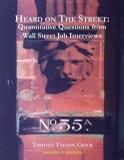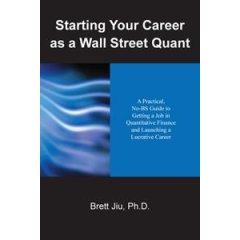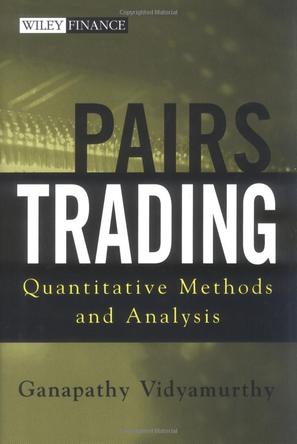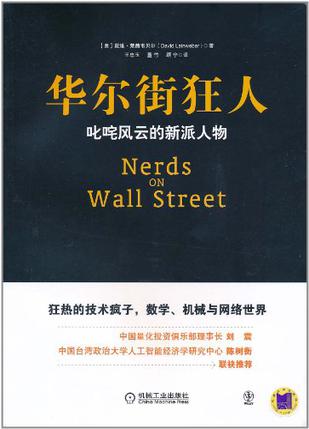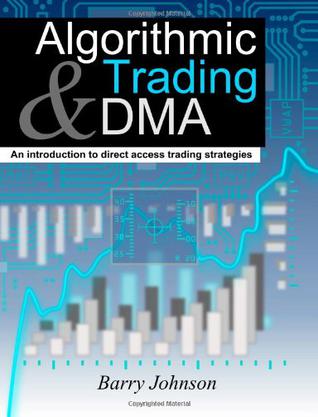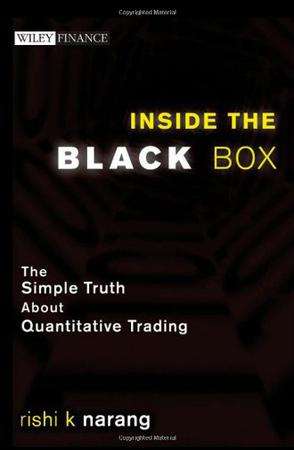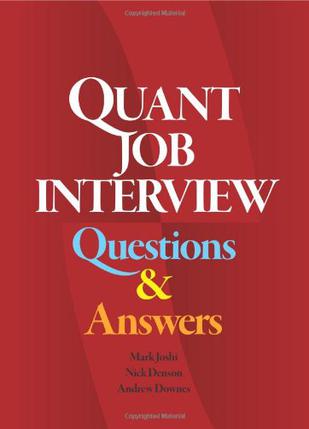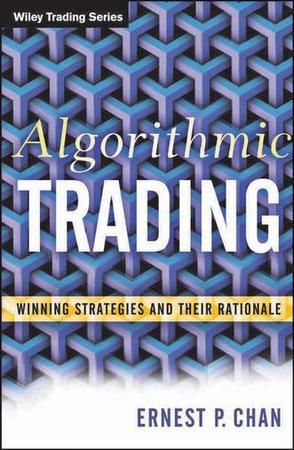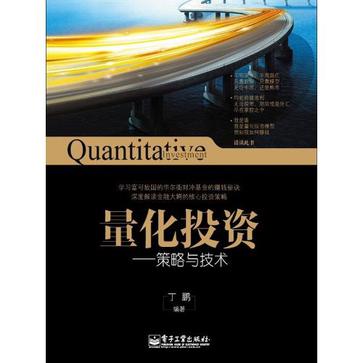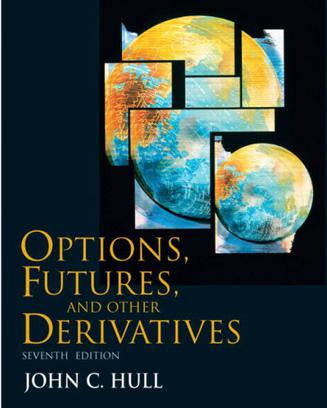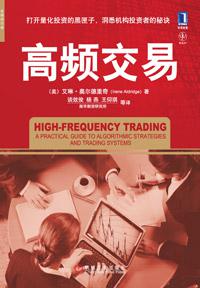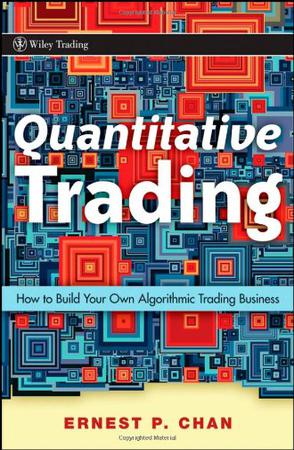欢迎来到相识电子书!
标签:quant
-
Heard on the Street
The book contains over 130 quantitative questions collected from actual investment banking, investment management, and options trading job interviews. The interviewers use the same questions year after year and here they are! These questions come from all types of interviews (corporate finance, sales and trading, quantitative research, etc), but they are especially likely in quantitative capital markets job interviews. The questions come from all levels of interviews (undergraduate, MBA, PhD), but they are especially likely if you have, or almost have, an MBA. The questions cover pure quantitative/logic, financial economics, derivatives, and statistics. Each quantitative question in the book is accompanied by a very detailed solution and by helpful advice. The latest edition also includes about 100 non-quantitative actual interview questions. Timothy Crack has a PhD from MIT. He has won many teaching awards and has publications in the top academic, practitioner, and teaching journals in finance. He has degrees in Mathematics/Statistics, Finance, and Financial Economics and a diploma in Accounting/Finance. Dr. Crack taught at the university level for 17 years including four years as a front line teaching assistant for MBA students at MIT. He now heads a quantitative active equity research team at the world's largest institutional money manager. -
Starting Your Career as a Wall Street Quant
All Practical, No BS! Working in quantitative finance can be highly rewarding, in both intellectual and monetary terms (but especially the latter!). Quants-finance practitioners who develop and apply sophisticated mathematical and statistical models for asset pricing, trading and risk management-routinely make six figures, with the top ones raking in millions each year. Starting Your Career as a Wall Street Quant is the first and only career guide specifically written for readers who want to get into quantitative finance and launch a lucrative career. It covers everything you wanted to know about getting a quant job, from writing an effective resume to acing job interviews to negotiating the job offer. Written by a practicing senior quant and packed with practical, useful tips (and devoid of BS that would get you nowhere), this book will help you get the quant job you want. Want to know what the single most critical element of your resume is? Want to know how to impress any interviewer as well as what to say and what not to say at a job interview? Want to know which books to study to acquire the right kind of quantitative education, the kind relevant to finance, and to gain an edge over your competitors? You'll find the answers to these questions, and many more, in this insider's guide. From the Author As a working quant, I've been to both sides of the job search process: I've been to many job interviews where I found my palms sweating wet all day long, and I've also been on the other side of the desk interviewing candidates whose palms were probably sweating wet. In writing this book, my goal is to offer you practical information and advice that can prove valuable in your quest to get a quant job on Wall Street. I call this book a "practical, no-BS guide" because that's what it is: lots of practical information you can use right away. I don't BS. I won't be selling you anything, and I don't have a hidden agenda like someone who is a professional headhunter might. I simply want to help you and others who are looking to start a quant career. It's that simple. (BTW, BS here does not stand for Black-Scholes!) You are welcome to visit the blog at http://quantcareer.spaces.live.com and try those quant questions on your own. -
Quantitative Equity Portfolio Management
Praise for Quantitative Equity Portfolio Management "A must-have reference for any equity portfolio manager or MBA student, this book is a comprehensive guide to all aspects of equity portfolio management, from factor models to tax management." ERIC ROSENFELD, Principal & Co-founder of JWM Partners "This is an ambitious book that both develops the broad range of artillery employed in quantitative equity investment management and provides the reader with a host of relevant practical examples. The book excels in melding theory with practice." STEPHEN A. ROSS, Franco Modigliani Professor of Financial Economics, Massachusetts Institute of Technology "The book is very comprehensive in its coverage, detailed in its discussions and written from a practical perspective without sacrificing needed rigor." DAVID BLITZER, Managing Director and Chairman, Standard & Poor's Index Committee "Making the transition from the walls of academia to Wall Street has traditionally been a difficult task!This book provides this link in a successful and engaging fashion, giving students of finance a road map for the application of financial theories in a real-world setting." MARK HOLOWESKO, CEO and Founder, Templeton Capital Advisors "This text provides an excellent synthesis of a broad range of quantitative portfolio management methods!In addition, there are a number of insightful innovations that extend and improve current techniques." DAN DIBARTOLOMEO, President and Founder, Northfield Information Services, Inc. Capitalize on Today's Most Powerful Quantitative Methods to Construct and Manage a High-Performance Equity Portfolio Quantitative Equity Portfolio Management is a comprehensive guide to the entire process of constructing and managing a high-yield quantitative equity portfolio. This detailed handbook begins with the basic principles of quantitative active management and then clearly outlines how to build an equity portfolio using those powerful concepts. Financial experts Ludwig Chincarini and Daehwan Kim provide clear explanations of topics ranging from basic models, factors and factor choice, and stock screening and ranking!to fundamental factor models, economic factor models, and forecasting factor premiums and exposures. Readers will also find step-by-step coverage of portfolio weights! rebalancing and transaction costs!tax management!leverage! market neutral!Bayesian _!performance measurement and attribution!the back testing process!and portfolio performance. Filled with proven investment strategies and tools for developing new ones, Quantitative Equity Portfolio Management features: A complete, easy-to-apply methodology for creating an equity portfolio that maximizes returns and minimizes risks The latest techniques for building optimization into a professionally managed portfolio An accompanying CD with a wide range of practical exercises and solutions using actual historical stock data An excellent melding of financial theory with real-world practice A wealth of down-to-earth financial examples and case studies Each chapter of this all-in-one portfolio management resource contains an appendix with valuable figures, tables, equations, mathematical solutions, and formulas. In addition, the book as a whole has appendices covering a brief history of financial theory, fundamental models of stock returns, a basic review of mathematical and statistical concepts, an entertaining explanation and quantitative approach to the casino game of craps, and other on-target supplemental materials. An essential reference for professional money managers and students taking advanced investment courses, Quantitative Equity Portfolio Management offers a full array of methods for effectively developing high-performance equity portfolios that deliver lucrative returns for clients. About the Authors Ludwig B. Chincarini, Ph.D., CFA, is a professor of finance at Georgetown University as well as a financial consultant to institutional investors. Previously, he was director of research at Rydex Global Advisors, the index mutual fund company. Prior to that, Dr. Chincarini was director of research at FOLIOfn, a brokerage firm that pioneered basket trading. He also worked at the Bank for International Settlements and holds a Ph.D. in economics from the Massachusetts Institute of Technology. Daehwan Kim, Ph.D., is a professor of economics at the American University in Bulgaria. Previously, he was employed as a financial economist for FOLIOfn. Dr. Kim also worked as a financial journalist, writing regular columns on financial markets for business media in Asia. He also holds a Ph.D. in economics from Harvard University. -
Pairs Trading
The first in-depth analysis of pairs trading Pairs trading is a market-neutral strategy in its most simple form. The strategy involves being long (or bullish) one asset and short (or bearish) another. If properly performed, the investor will gain if the market rises or falls. Pairs Trading reveals the secrets of this rigorous quantitative analysis program to provide individuals and investment houses with the tools they need to successfully implement and profit from this proven trading methodology. Pairs Trading contains specific and tested formulas for identifying and investing in pairs, and answers important questions such as what ratio should be used to construct the pairs properly. -
华尔街狂人
《华尔街狂人》讲述的是发生在当今世界金融市场中日新月异的技术变革的故事。技术对于投资行业的影响意义深远,作者戴维·莱茵韦贝尔为读者展现了华尔街的过去和未来走向。要成为一位长期成功的投资人,并非只与股票的选择、资产的分配或是对市场时机的把握有关,它还与技术相关。 从根本上,金融业的游戏规则已经变了,由于技术的发展,这种变化还将继续进行。新加入的“玩家”在给投资人提供机遇的同时也带来了风险。通过这本趣味性极强的书,戴维·莱茵韦贝尔分?并阐述技术在哪些方面已经深入融合到了华尔街,这意味着什么,以及这对未来的市场会有何种影响。 -
Algorithmic Trading and DMA
Algorithmic trading and Direct Market Access (DMA) are important tools helping both buy and sell-side traders to achieve best execution. This book starts from the ground up to provide detailed explanations of both these techniques: - An introduction to the different types of execution is followed by a review of market microstructure theory. Throughout the book examples from empirical studies bridge the gap between the theory and practice of trading. - Orders are the fundamental building blocks for any strategy. Market, limit, stop, hidden, iceberg, peg, routed and immediate-or-cancel orders are all described with illustrated examples. - Trading algorithms are explained and compared using charts to show potential trading patterns. TWAP, VWAP, Percent of Volume, Minimal Impact, Implementation Shortfall, Adaptive Shortfall, Market On Close and Pairs trading algorithms are all covered, together with common variations. - Transaction costs can have a significant effect on investment returns. An in-depth example shows how these may be broken down into constituents such as market impact, timing risk, spread and opportunity cost and other fees. - Coverage includes all the major asset classes, from equities to fixed income, foreign exchange and derivatives. Detailed overviews for each of the world's major markets are provided in the appendices. - Order placement and execution tactics are covered in more detail, as well as potential enhancements (such as short-term forecasts), for those interested in the specifics of implementing these strategies. - Cutting edge applications such as portfolio and multi-asset trading are also considered, as are handling news and data mining/artificial intelligence. -
Inside the Black Box
Inside The Black Box The Simple Truth About Quantitative Trading Rishi K Narang Praise for Inside the Black Box "In Inside the Black Box: The Simple Truth About Quantitative Trading , Rishi Narang demystifies quantitative trading. His explanation and classification of alpha will enlighten even a seasoned veteran." —Blair Hull, Founder, Hull Trading & Matlock Trading "Rishi provides a comprehensive overview of quantitative investing that should prove useful both to those allocating money to quant strategies and those interested in becoming quants themselves. Rishi's experience as a well-respected quant fund of funds manager and his solid relationships with many practitioners provide ample useful material for his work." —Peter Muller, Head of Process Driven Trading, Morgan Stanley "A very readable book bringing much needed insight into a subject matter that is not often covered. Provides a framework and guidance that should be valuable to both existing investors and those looking to invest in this area for the first time. Many quants should also benefit from reading this book." —Steve Evans, Managing Director of Quantitative Trading, Tudor Investment Corporation "Without complex formulae, Narang, himself a leading practitioner, provides an insightful taxonomy of systematic trading strategies in liquid instruments and a framework for considering quantitative strategies within a portfolio. This guide enables an investor to cut through the hype and pretense of secrecy surrounding quantitative strategies." —Ross Garon, Managing Director, Quantitative Strategies, S.A.C. Capital Advisors, L.P. "Inside the Black Box is a comprehensive, yet easy read. Rishi Narang provides a simple framework for understanding quantitative money management and proves that it is not a black box but rather a glass box for those inside." —Jean-Pierre Aguilar, former founder and CEO, Capital Fund Management "This book is great for anyone who wants to understand quant trading, without digging in to the equations. It explains the subject in intuitive, economic terms." —Steven Drobny, founder, Drobny Global Asset Management, and author, Inside the House of Money "Rishi Narang does an excellent job demystifying how quants work, in an accessible and fun read. This book should occupy a key spot on anyone's bookshelf who is interested in understanding how this ever increasing part of the investment universe actually operates." —Matthew S. Rothman, PhD, Global Head of Quantitative Equity Strategies Barclays Capital "Inside the Black Box provides a comprehensive and intuitive introduction to "quant" strategies. It succinctly explains the building blocks of such strategies and how they fit together, while conveying the myriad possibilities and design details it takes to build a successful model driven investment strategy." —Asriel Levin, PhD, Managing Member, Menta Capital, LLC -
The Concepts and Practice of Mathematical Finance
An ideal introduction for those starting out as practitioners of mathematical finance, this book provides a clear understanding of the intuition behind derivatives pricing, how models are implemented, and how they are used and adapted in practice. Strengths and weaknesses of different models, e.g. Black-Scholes, stochastic volatility, jump-diffusion and variance gamma, are examined. Both the theory and the implementation of the industry-standard LIBOR market model are considered in detail. Each pricing problem is approached using multiple techniques including the well-known PDE and martingale approaches. This second edition contains many more worked examples and over 200 exercises with detailed solutions. Extensive appendices provide a guide to jargon, a recap of the elements of probability theory, and a collection of computer projects. The author brings to this book a blend of practical experience and rigorous mathematical background and supplies here the working knowledge needed to become a good quantitative analyst. -
Algorithmic Trading
Praise for Algorithmic Trading: "Algorithmic Trading is an insightful book on quantitative trading written by a seasoned practitioner. What sets this book apart from many others in the space is the emphasis on real examples as opposed to just theory. Concepts are not only described, they are brought to life with actual trading strategies, which give the reader insight into how and why each strategy was developed, how it was implemented, and even how it was coded. This book is a valuable resource for anyone looking to create their own systematic trading strategies and those involved in manager selection, where the knowledge contained in this book will lead to a more informed and nuanced conversation with managers." (Daren Smith, CFA, CAIA, FSA, Managing Director, Manager Selection & Portfolio Construction, University of Toronto Asset Management). "Using an excellent selection of mean reversion and momentum strategies, Ernie explains the rationale behind each one, shows how to test it, how to improve it, and discusses implementation issues. His book is a careful, detailed exposition of the scientific method applied to strategy development. For serious retail traders, I know of no other book that provides this range of examples and level of detail. His discussions of how regime changes affect strategies, and of risk management, are invaluable bonuses." (Roger Hunter, Mathematician and Algorithmic Trader). -
Algorithmic Trading
Praise for Algorithmic Trading: "Algorithmic Trading is an insightful book on quantitative trading written by a seasoned practitioner. What sets this book apart from many others in the space is the emphasis on real examples as opposed to just theory. Concepts are not only described, they are brought to life with actual trading strategies, which give the reader insight into how and why each strategy was developed, how it was implemented, and even how it was coded. This book is a valuable resource for anyone looking to create their own systematic trading strategies and those involved in manager selection, where the knowledge contained in this book will lead to a more informed and nuanced conversation with managers." (Daren Smith, CFA, CAIA, FSA, Managing Director, Manager Selection & Portfolio Construction, University of Toronto Asset Management). "Using an excellent selection of mean reversion and momentum strategies, Ernie explains the rationale behind each one, shows how to test it, how to improve it, and discusses implementation issues. His book is a careful, detailed exposition of the scientific method applied to strategy development. For serious retail traders, I know of no other book that provides this range of examples and level of detail. His discussions of how regime changes affect strategies, and of risk management, are invaluable bonuses." (Roger Hunter, Mathematician and Algorithmic Trader). -
量化投资
《量化投资—策略与技术》是国内第一本有关量化投资策略的著作,首先介绍了量化投资大师西蒙斯的传奇故事(连续20年,每年赚60%);然后用60多个案例介绍了量化投资的各个方面的内容,主要分为策略篇与理论篇两部分,策略篇主要包括:量化选股、量化择时、股指期货套利、商品期货套利、统计套利、期权套利、算法交易和资产配置等。理论篇主要包括:人工智能、数据挖掘、小波分析、支持向量机、分形理论、随机过程及it技术等;最后介绍了作者开发的d-alpha量化对冲交易系统,该系统全球市场验证显示具有长期稳健的收益率。 《量化投资—策略与技术》适合基金经理、证券分析师、普通散户及有志于从事金融投资的各界人士阅读。 -
The Concepts and Practice of Mathematical Finance (Mathematics, Finance and Risk)
This introductory text provides a clear understanding of the intuition behind derivatives pricing, how models are implemented, and how they are used and adapted in practice. M. Joshi covers the strengths and weaknesses of such models as stochastic volatility, jump diffusion, and variance gamma, as well as the Black-Scholes. Examples and exercises, with answers, as well as computer projects, challenge the mind and encourage learning how to become a good quantitative analyst. -
Monte Carlo Methods in Finance
An invaluable resource for quantitative analysts who need to run models that assist in option pricing and risk management. This concise, practical hands on guide to Monte Carlo simulation introduces standard and advanced methods to the increasing complexity of derivatives portfolios. Ranging from pricing more complex derivatives, such as American and Asian options, to measuring Value at Risk, or modelling complex market dynamics, simulation is the only method general enough to capture the complexity and Monte Carlo simulation is the best pricing and risk management method available. The book is packed with numerous examples using real world data and is supplied with a CD to aid in the use of the examples. -
MATHEMATICAL METHODS FOR FOREIGN EXCHANGE - A FINANCIAL ENGINEER'S APPROACH
This comprehensive book presents a systematic and practically oriented approach to mathematical modeling in finance, particularly in the foreign exchange context. It describes all the relevant aspects of financial engineering, including derivative pricing, in detail. The book is self-contained, with the necessary mathematical, economic, and trading background carefully explained. In addition to the lucid treatment of the standard material, it describes many original results. The book can be used both as a text for students of financial engineering, and as a basic reference for risk managers, traders, and academics. -
An Introduction to the Mathematics of Financial Derivatives, Second Edition
This popular text, publishing Spring 1999 in its Second Edition, introduces the mathematics underlying the pricing of derivatives. The increase of interest in dynamic pricing models stems from their applicability to practical situations: with the freeing of exchange, interest rates, and capital controls, the market for derivative products has matured and pricing models have become more accurate. Professor Neftci's book answers the need for a resource targeting professionals, Ph.D. students, and advanced MBA students who are specifically interested in these financial products. The Second Edition is designed to make the book the main text in first year masters and Ph.D. programs for certain courses, and will continue to be an important manual for market professionals. -
高频交易
以光速旅行,决胜于分秒之间 揭开量化投资的黑匣子,洞悉机构投资者的秘诀 量化投资方法正越来越受到广大的机构投资投资者的关注,其代表者吉姆·西蒙斯在股市下行的2008年中将25亿美元的收益收入囊中。高频交易作为量化投资的重要方法,也引起了海内外投资界的广泛兴趣。据不完全统计,2008年,采用传统低频交易的投资者有70%处于亏损,而高频交易基金经理几乎都在当年实现了盈利。 那么究竟何为高频交易?高频交易背后的原理是什么?量化投资者又是怎样利用这一工具实现惊人的收益呢? 本书作者站在专业的高度,用平实的语言和丰富的图表,带我们走进量化投资的黑匣子,向我们展示了这台复杂的“金融仪器”是如何运作的。书中的内容涵盖了高频交易的方方面面——从形成想法并开发交易系统,到投入资金并进行表现评估——这些详实的信息将让你在如今风云诡谲的市场上更具竞争优势。 -
Quantitative Trading
By some estimates, quantitative (or algorithmic) trading now accounts for over one-third of trading volume in the United States. While institutional traders continue to implement this highly effective approach, many independent traders—with limited resources and less computing power—have wondered if they can still challenge powerful industry professionals at their own game? The answer is "yes," and in Quantitative Trading, author Dr. Ernest Chan, a respected independent trader and consultant, will show you how. Whether you're an independent "retail" trader looking to start your own quantitative trading business or an individual who aspires to work as a quantitative trader at a major financial institution, this practical guide contains the information you need to succeed. Organized around the steps you should take to start trading quantitatively, this book skillfully addresses how to: * Find a viable trading strategy that you're both comfortable with and confident in * Backtest your strategy—with MATLAB®, Excel, and other platforms—to ensure good historical performance * Build and implement an automated trading system to execute your strategy * Scale up or wind down your strategies depending on their real-world profitability * Manage the money and risks involved in holding positions generated by your strategy * Incorporate advanced concepts that most professionals use into your everyday trading activities * And much more While Dr. Chan takes the time to outline the essential aspects of turning quantitative trading strategies into profits, he doesn't get into overly theoretical or sophisticated theories. Instead, he highlights the simple tools and techniques you can use to gain a much-needed edge over today's institutional traders. And for those who want to keep up with the latest news, ideas, and trends in quantitative trading, you're welcome to visit Dr. Chan's blog, epchan.blogspot.com, as well as his premium content Web site, epchan.com/subscriptions, which you'll have free access to with purchase of this book. As an independent trader, you're free from the con-straints found in today's institutional environment—and as long as you adhere to the discipline of quantitative trading, you can achieve significant returns. With this reliable resource as your guide, you'll quickly discover what it takes to make it in such a dynamic and demanding field.
热门标签
下载排行榜
- 1 梦的解析:最佳译本
- 2 李鸿章全传
- 3 淡定的智慧
- 4 心理操控术
- 5 哈佛口才课
- 6 俗世奇人
- 7 日瓦戈医生
- 8 笑死你的逻辑学
- 9 历史老师没教过的历史
- 10 1分钟和陌生人成为朋友

